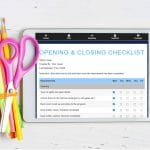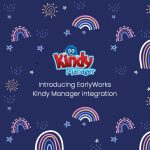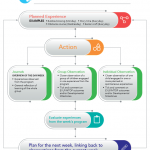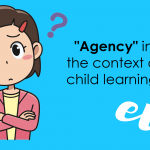EarlyWorks and the Assessment and Planning Cycle
Without a doubt, the one topic that comes up most often in conversations with EarlyWorks educators is the planning cycle and how to document it. This isn’t surprising as educators live and breathe this process. In fact, in the phone conversations it’s clear that educators put their hearts and souls into each part of that process in order to provide the best possible education and care for every child in their service.
Something I really like about EarlyWorks is that it provides educators with flexibility and options as to where and how they document what is happening at each stage of the cycle. This is so important, as it is stated in the Guide to the NQF that “Documentation should occur at each stage of the cycle.” We all want to make sure that all that happens in the assessment and planning cycle process is clearly documented, particularly for assessment and ratings.
The diagram below shows the NQF Assessment and Planning Cycle and the ways you might document each part of that cycle in EarlyWorks.
During the first step of the planning cycle, observing and collecting information, it’s likely educators will be drawing on information from a variety of sources: conversations with families, conversations with children, work samples, photos, observations, journals, daily communications, information from allied health/education professionals, and the community. Using EarlyWorks this information gathered during this step can be documented in Observations, Time Samples, Journals, Daily Communications, Child Documents, Photos with captions, and Child Comments.
The next step of the planning cycle process is analysing the learning. Here we are asking ourselves what our observations and all the information we have collected tell us about the child? What do we make of all the information we have gathered? This is where, using EarlyWorks’ Observations, we can link to the learning outcomes and developmental milestones for each child. In the reflection of learning, we can delve deeper into what learning has happened for all the children included in observations. What did we learn from the way they interacted with each other? How did the children learn from and with each other? What learning happened and how did it happen?
So far we have been focusing on what we have seen. The next stage, planning, is all about what we are going to do. Using all the documentation created during the first two steps, observing and analysing, we can plan for future learning. We need to think about what we are intending to achieve (intentional teaching 1.2.1) and how we will achieve that. Using EarlyWorks, this will all be documented as an Experience. In the narrative of the experience we provide a written account of what we are going to do. How will we engage the children? What strategies will we use? What resources will we need? What preparation will we need to do beforehand? Under preceding observations we can make clear links to the observations and journals or non-program related elements that are informing our Experience. Using the Children Planned for, we can tick the children we are planning for. Under intended outcomes we can tick the outcomes we are intending to achieve. We can include images or documents as resources to help with the delivery of the experience. And finally, if we think this experience could be used as evidence of any of the NQS we can tick the appropriate standard or element for inclusion in the service’s QIP evidence list.
Experiences might be for individual children or groups of children. Experiences might even be changes we are making to the indoor and outdoor spaces. We may also use Experiences to document individual and group goals. These goals will likely be informed by all of the information collected and analysed in the first two steps of the planning cycle.
The next step is the most exciting! This is where we get to implement our planned experiences. While interacting with the children as we deliver the planned experiences, we will likely be looking for teachable moments, as well as ways to facilitate relationships, develop curiosity, extend on learning, and encourage persistence. We might also begin documenting through photos and jottings which can be included in our next observations.
The final step is reflecting and evaluating. Using the Evaluation of Experience in EarlyWorks, we might jot down how we think the experience went? Were the intended outcomes achieved? Were there some unexpected outcomes? Were the resources appropriate? Were the teaching strategies effective? How might we do things differently next time?
According to the National Quality Guide, reflecting and evaluating should happen at every step of the planning cycle process. Using EarlyWorks you might use Program Comments to chat and reflect as a team about how the program is going. What is working? Where might you take the children’s learning next? Where can we improve? Are we living out the philosophy of our service?
Another place to critically reflect at any stage of the planning cycle process is in Reflections of Pedagogy. Here educators can reflect individually on the Principles, Practices, NQS, theorists, and any other big or little questions related to our practice, the children and families in our care, or our community.
The Assessment and Planning Cycle is so much more than a set of steps to be methodically trodden through. It is a vibrant process that is limited only by the creativity of the educators, children, families and communities involved.







